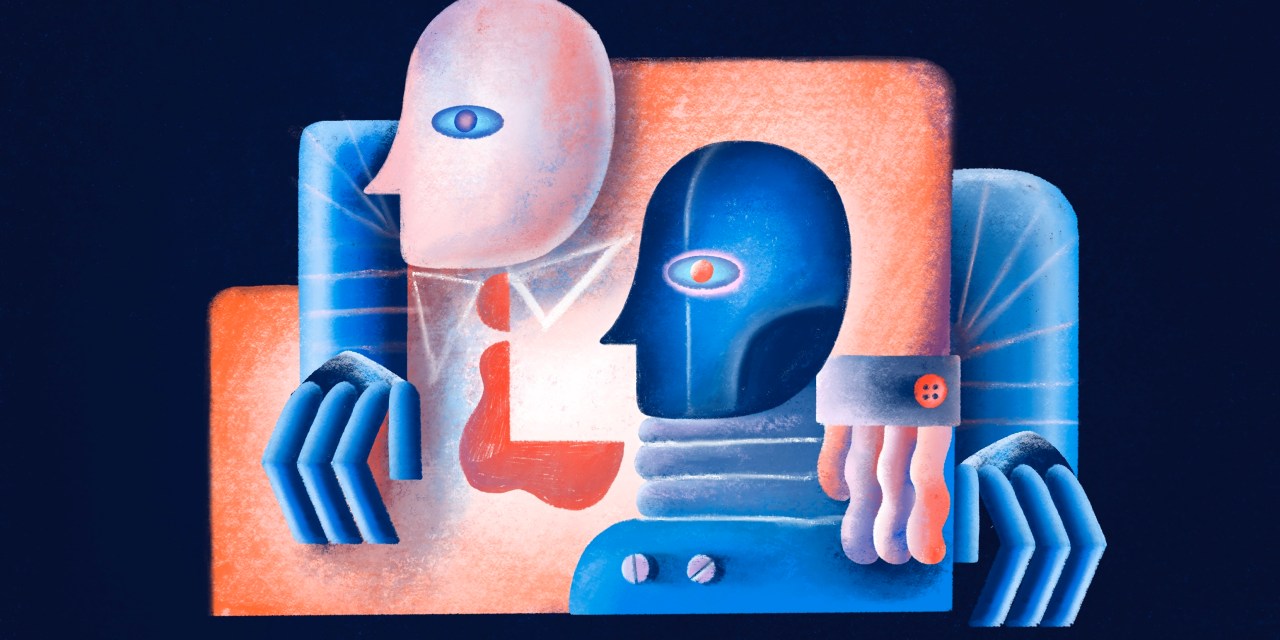Here are artificial intelligence’s biggest misconceptions

This article is part of WorkLife’s artificial intelligence special edition, which breaks through the hype around AI – both traditional and generative – and examines what its role will be in the future of work, for desk-based workers. More from the series →
Whether it’s fake photos of explosions that go viral, endless calls for regulation, or competitive product announcements from big tech companies, artificial intelligence is dominating the headlines on a daily basis.
The disruptive role AI and automation will have in our future working lives has long been debated. But when the generative AI tool ChatGPT, developed by OpenAI, burst into the mainstream at the end of 2022, it accelerated and compounded our deepest underlying fear about the tech: that AI will usurp our jobs.
But beyond the hype, the reality is very different. It’s true that the generative AI genie is well and truly out of the bottle: it will transform the ways workers interact with each other and their employers or clients. But it won’t decimate all jobs. Rather, it will evolve them, and in some cases could even create more jobs.
So what’s what? What should we worry about and what is mere hype? We have taken some of the most common AI misconceptions that have created a sense of panic and debunked them in the below myth buster.
Myth: AI will take over my job.
AI-driven anxiety is reaching new heights, with a third of workers worried about being replaced by tech in the next three years. Couple this with rapid AI advancements and Goldman Sachs’ claims that the latest wave of AI innovation could affect 300 million jobs, and this anxiety isn’t surprising.
However, this is a concern experts want to alleviate.
There are some kinds of work – the mundane, repetitive, time-consuming kind – that are crying out for more automation. Determining where and how AI can best be used to free up human employees’ time so they can focus on other tasks that are, for example, more creative and require a human thinker, will give businesses a competitive edge, experts say.
That’s why leaders are actually encouraging their employees to use AI to boost their productivity. In fact, some employers are even paying for ChatGPT Plus subscriptions for their employees to free up their time to do deeper work instead.
While some people are worried that using AI will make their role redundant, it’s often not the case. Progressive business leaders see it as an opportunity for their employees to shift the kind of work they do, making them more efficient.
Plus, the tech itself isn’t ready. Just check out what happened when a New York lawyer over-relied on ChatGPT for background research to help win his case in court. The chatbot actually made up fake legal cases, which the lawyer then used in court, landing himself in major hot water.
Ultimately, it’s the harmony between humans and AI that matters the most.
“We have a belief that the AI’s job should be a copilot or companion,” said Scott Litman, founder and COO of Lucy, an AI-powered answer engine. “The individual needs to stay on the wheel. If an individual operates alone without the AI, or the AI operates alone without the individual, there is a huge missing piece. But the two together become very powerful.”
Lupe Colangelo, interim head of talent placements at technical and business education and career provider General Assembly, said that she’s seen tech candidates embrace the emergence of AI as they enter the workforce.
“Like any technology, there can always be a fear of being replaced, but like any other technology that comes into play, it helps automate things but it’s not going to fully replace,” said Colangelo. “There is still so much space for the humans working on these tools to remain there and own the digital transformation.”
She anticipates more jobs emerging in the AI space, beyond prompt engineers, including AI trainers, AI ethicists, and machine managers.
Myth: Companies are only using AI to cut costs.
It’s true that using AI can help reduce some costs in the workplace. For example, it can automate routine tasks and allow that employee to work on something else that might have a higher return on investment. However, it’s certainly not the only reason companies are taking advantage of it. Some experts believe that if companies aren’t capitalizing on AI they could fall behind entirely.
Litman said that the use cases for AI will depend on the business.
“In any given vertical application, there are going to be questions like what is the impact, is someone trying to save time, are they trying to increase capacity, are they trying to decrease wait times or increase customer satisfaction?,” said Litman. “It’s going to vary business to business and use case to use case.”
Adam Famularo, CEO of WorkFusion, an automation solutions company for Fortune 500 enterprises, banks, insurance, and financial services, said that implementing this technology now can help companies set themselves apart from competitors, given it is still on the newer side.
“You’re always looking at keeping a competitive advantage in the marketplace,” said Famularo. “Adopting new technologies has always been a way to help set yourself up to be different in the marketplace and be more efficient and effective.”
Myth: AI and machine learning are the same thing.
While the spotlight on AI over the past six months has been intensive, what experts refer to as “traditional” AI (focuses on detecting patterns, making decisions, honing analytics, classifying data and detecting fraud) has been rumbling along under the surface for years, with many businesses having adopted it for several years. As has machine learning, which is a type of AI. But the two terms are often used interchangeably, just like traditional AI and generative AI (produces new content, chat responses, designs, synthetic data or deep fakes, like ChatGPT, DALL-E) are.
It can get confusing fast. (check out WorkLife’s AI glossary to help sort through the new AI lingo.)
Machine learning is a subset of AI which focuses on the development of algorithms that can learn and make predictions or decisions based on data. It involves training machines to recognize patterns and make better decisions. For example, ChatGPT uses machine learning techniques to understand and generate human-like language. But the terms should not be used interchangeably.
“AI is really the broad category of machine intelligence,” said Litman. “Machine learning is a subset of how you train AI.”
Myth: AI won’t impact my sector.
When it comes to AI, sticking your head in the sand entirely will backfire. Robots have long been associated with automating more manual, repetitive jobs, typically in blue-collar industries like manufacturing and logistics. For example, Amazon uses AI to handle millions of items in its warehouses.
But it’s now having a significant impact in a wide range of industries, including corporate, desk-based jobs like financial services, where Morgan Stanley has a new OpenAI-powered chatbot. Meanwhile, management consultancy PwC will invest $1 billion to expand AI capabilities within its organization, to automate parts of its tax, audit and consulting services, and upskill its employees.
“When email was first allowed at our jobs we could only email certain times of the day and then it was shut down because they didn’t want us to lose productivity,” said Famularo. “But if you think about what email and the internet has brought to our lives, it’s huge. It’s the same thing with AI. We’re all going to use it.”
Famularo believes the disruption AI causes will be mostly positive and it should be viewed as a technology that can help people do their jobs better.
“It’s where a marketing person will be able to do their job better than they were able to do it before, or a legal executive can write legal documents faster than they were able to do before,” said Famularo. “Each role and function will have their own twist on how they will use AI to make themselves more effective. I don’t see any industry not being impacted by it.”
Myth: Companies using AI don’t care about me.
This somewhat common sentiment isn’t helped by some senior leaders’ public statements around how they plan to deploy AI. For example, IBM CEO Arvind Krishna’s comments to Bloomberg that he’ll use AI to slash IBM’s workforce, aren’t going to appease any anxiety around the topic. But they’re the exception rather than the norm. Most CEOs have been circumspect about how they plan to use AI to enhance their workforce’s capabilities, like PwC’s plan to upskill its workers to be proficient users of AI.
And one might argue that a company encouraging you to use AI cares about you even more than a company that doesn’t. For example, using AI allows employees to have more time to focus on deep work that they might not have had time for before if their calendar was filled with time-consuming tasks that could have been automated. Best case scenario, that could leave employees feeling more satisfied with their day-to-day work, free up mental strain and even potentially stave off future burnout.
That’s of course if the employer then doesn’t demand a significantly higher output of work every day from that employee, causing additional stress.
In short, companies will largely use AI to improve the efficiency and productivity of workforces and the experience of their customers. But that doesn’t mean that the company doesn’t care about their workers. “There is constant disruption in the workplace with new tools,” added Litman.
Myth: AI can be completely objective.
If we take ChatGPT for example, there are a number of ways in which it is not totally objective. It can often hallucinate, like other AI-powered language processing tools. That means it can give an output that seems entirely right, but is actually inaccurate. It means that people using these sorts of tools need to be mindful of fact checking and verifying the answers given.
“One of the things we think is really critical is how important it is that it can cite the evidence of where the machine created the answer from so we can verify it’s truthful and accurate,” said Litman.
AI systems may also hold bias if the training data used to develop the system contained biases or inaccuracies. We’ve already seen the fallout of when this happens, including Amazon’s recruitment system that automatically rejected CVs from women applicants, Google’s photo app which labeled a picture of a Black couple as “gorillas” and the racial disparities in the accuracy of facial detection systems exposed by Joy Buolamwini and Timnit Gebru.
These cases have highlighted the importance of responsible, ethical AI that doesn’t include bias or discrimination of any kind.
“People are concerned about the bias with generative AI, but the bias isn’t in the AI, it’s in the underlying data,” said Litman. “If the data is biased, the responses will be biased.”
Myth: My company doesn’t need an AI strategy.
If a company wants to be at the cutting edge of the future of work, experts say that an AI strategy should be a top priority if it’s not already in place. Currently, only 35% of businesses use AI, while 42% are considering implementing it in the near future, according to recent findings.
“Companies do need to take the time to think about ‘what is our AI strategy and direction,’ and make sure they put together what their plan is for adopting the technology,” said Famularo.
He said that most of the current conversations are around where companies should place guardrails around the usage of AI to ensure that poor decisions aren’t made. It’s helpful for companies to share policies about how they should be using AI at work, he added.
“You should think about how you’re going to enable your employees to use it without worry of compromise, and you should think about how you’re adopting new technologies to take on certain tasks,” said Famularo.
Colangelo agrees and stressed that being thoughtful about this digital transformation is critical.
“It’s really important to make sure that we are keeping people first when it comes to your technology strategy,” said Colangelo. “Any company that is adopting AI, you want to make sure that you’re getting feedback from your employees to understand how it can make their roles more efficient, how it can be used to reskill or upskill, and how to invest in talent. My recommendation for organizations is to think long term.”

